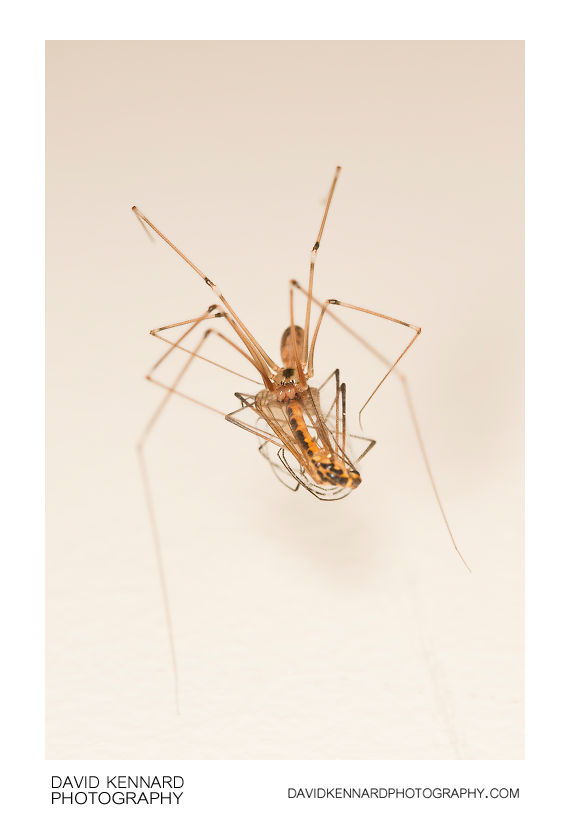Pholcus phalangioides eating Nephrotoma appendiculata

Description
- Title:
- Pholcus phalangioides eating Nephrotoma appendiculata
- Caption / Description:
-
The cellar spider or daddy longlegs (Pholcus phalangioides), also known as the skull spider due to its cephalothorax looking like a human skull, is a spider of the family Pholcidae. Females have a body length of about 9 mm; males are slightly smaller. Its legs are about 5 or 6 times the length of its body (reaching up to 7 cm of leg span in females).
Its habit of living on the ceilings of rooms, caves, garages or cellars gives rise to its common name of 'cellar spider'. In Australian homes, they are considered beneficial because it is sometimes believed they will kill and eat the venomous Redback spider.
This is the only spider species described by the Swiss entomologist Johann Kaspar Füssli who first recorded it for science in 1775. Confusion often arises over its common name, because "daddy longlegs" is also applied to two other unrelated arthropods: the harvestman and the crane fly.
Pholcus phalangioides has the habit of shaking its web violently when disturbed as a defence mechanism against predators. They can easily catch and eat other spiders (even those much larger than itself, such as Tegenaria duellica), mosquitoes and other insects, and woodlice. When food is scarce, they will prey on their own kind.
Because they originally came from the tropics, these spiders do not seem to be aware of seasonal changes and breed at any time of the year. The female holds the 20 to 30 eggs in her pedipalps. Spiderlings are transparent with short legs and change their skin about 5 or 6 times as they mature.
Description taken from Wikipedia: http://en.wikipedia.org/wiki/Pholcus_phalangioides
- Tags / Keywords:
-
- Biota
- Life
- Vitae
- Eukaryota
- Animalia
- Animals
- Arthropoda
- Arthropods
- Insecta
- Insects
- Diptera
- Flies
- Arachnida
- Arachnids
- Araneae
- Spiders
- Pholcidae
- Daddy longlegs spiders
- Pholcus
- Pholcus phalangioides
- Cellar spider
- Tipulidae
- Crane flies
- Daddy long legs
- Nephrotoma
- Tiger crane flies
- Nephrotoma appendiculata
- Spotted crane fly
Admin
- Date Original Photo Taken:
- Original File Name:
- _MG_3170.CR2
- Event:
- Rating:
- ☆
- Date this image added/last updated on website:
- Original File Dimensions:
- 2848px x 4272px
- File Type:
- JPEG
- Color Mode:
- RGB
- Original Image Color Profile:
- Adobe RGB (1998)
Location
- Location Created:
-
- Sublocation:
- City:
- Market Harborough
- Province/State:
- Leicestershire
- Country:
- United Kingdom
- World Region:
- Europe
- Geo-location:
Rights
- Copyright Status:
- Copyrighted
- Licensing Status:
- Rights Managed
- Available for Editorial Use:
- Yes
- Available for Commercial Use:
- Yes
- Copyright Notice:
- © 2010 Dave Kennard
Camera Data
- Date Digital Resource was created:
- Shutter speed:
- 1⁄200 s
- Aperture:
- f/8
- Camera Model:
- Canon EOS 450D
- ISO:
- 100
- Exposure Compensation:
- 0
- Focal Length:
- 100mm
- Focal Length (35mm equiv.):
- Metering Mode:
- Multi-segment
- Flash:
- On, Fired
- Exposure Mode:
- Manual
- White Balance:
- Manual
- Light Source:
- Exposure Program:
- Manual
Additional shooting metadata
- Lens:
- Canon EF 100mm F2.8 Macro USM
- Filters used:
- Additional Optics used:
- Setup:
- Handheld
Canon MT-24EX Macro Twin Flash with home-made concave diffusers
Post Processing
- Image Modified:
- Software used:
-
- Adobe Camera RAW
- Post Processing:
20 recovery in ACR
+11 clarity in ACR
Strong curves adjustment to increase contrast in ACR
